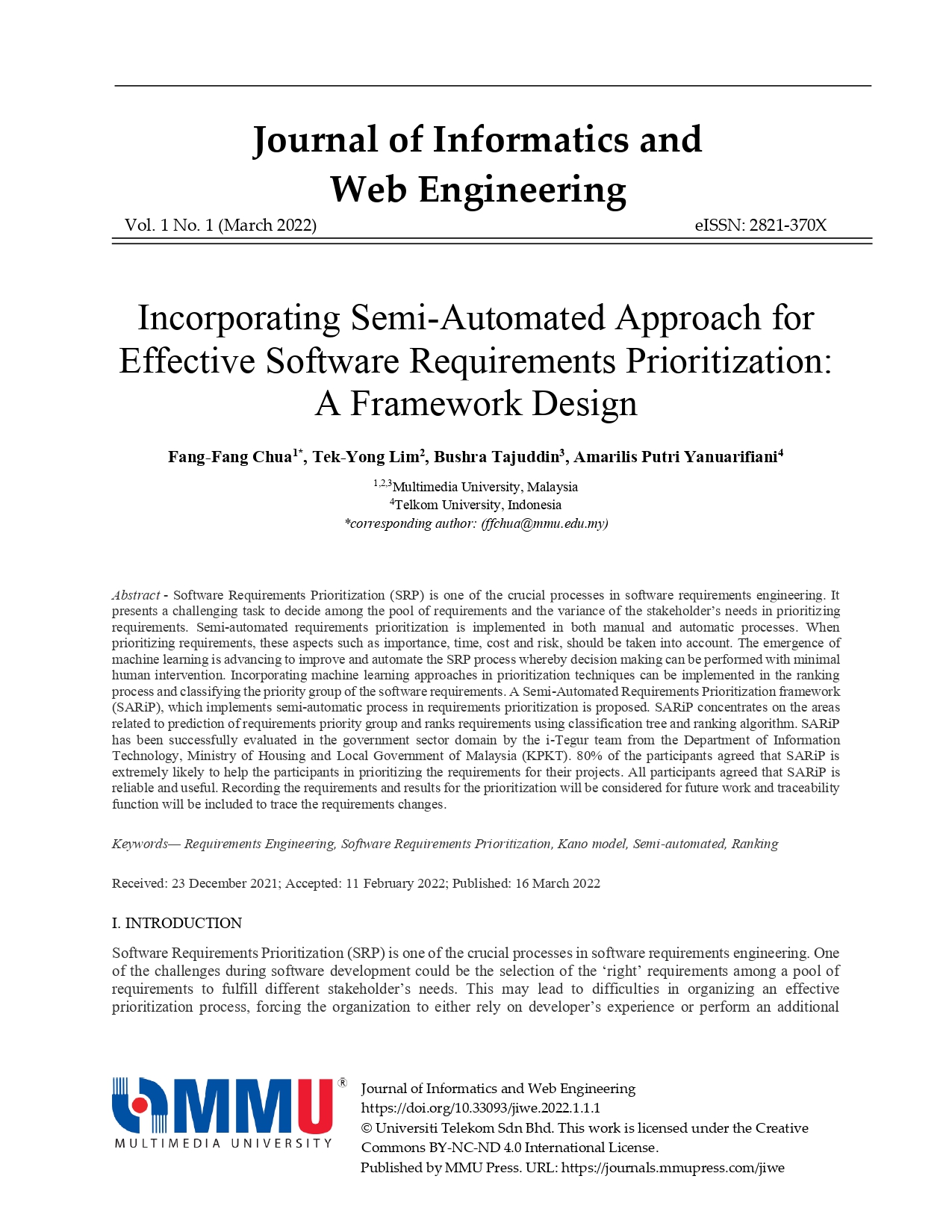Incorporating Semi-Automated Approach for Effective Software Requirements Prioritization: A Framework Design
Main Article Content
Abstract
Software Requirements Prioritization (SRP) is one of the crucial processes in software requirements engineering. It presents a challenging task to decide among the pool of requirements and the variance of the stakeholder’s needs in prioritizing requirements. Semi-automated requirements prioritization is implemented in both manual and automatic processes. When prioritizing requirements, these aspects such as importance, time, cost and risk, should be taken into account. The emergence of machine learning is advancing to improve and automate the SRP process whereby decision making can be performed with minimal human intervention. Incorporating machine learning approaches in prioritization techniques can be implemented in the ranking process and classifying the priority group of the software requirements. A Semi-Automated Requirements Prioritization framework (SARiP), which implements semi-automatic process in requirements prioritization is proposed. SARiP concentrates on the areas related to prediction of requirements priority group and ranks requirements using classification tree and ranking algorithm. SARiP has been successfully evaluated in the government sector domain by the i-Tegur team from the Department of Information Technology, Ministry of Housing and Local Government of Malaysia (KPKT). 80% of the participants agreed that SARiP is extremely likely to help the participants in prioritizing the requirements for their projects. All participants agreed that SARiP is reliable and useful. Recording the requirements and results for the prioritization will be considered for future work and traceability function will be included to trace the requirements changes.
Article Details

This work is licensed under a Creative Commons Attribution-NonCommercial-NoDerivatives 4.0 International License.
All articles published in JIWE are licensed under a Creative Commons Attribution-NonCommercial-NoDerivatives 4.0 International (CC BY-NC-ND 4.0) License. Readers are allowed to
- Share — copy and redistribute the material in any medium or format under the following conditions:
- Attribution — You must give appropriate credit, provide a link to the license, and indicate if changes were made. You may do so in any reasonable manner, but not in any way that suggests the licensor endorses you or your use;
- NonCommercial — You may not use the material for commercial purposes;
- NoDerivatives — If you remix, transform, or build upon the material, you may not distribute the modified material.
References
K. Wiegers, and J. Beatty, "Software requirements: 3-rd edition", Microsoft Press, Washington, 2013.
K. AbdElazim, R. Moawad, E. Elfakharany, "A framework for requirements prioritization process in agile software development", Journal of Physics: Conference Series, vol. 1454, no. 1, 012001, IOP Publishing, 2020.
M. Schedlbauer. “Requirements Prioritization Strategies”, CEG, 2018. https://www.corpedgroup.com/resources/ba/ReqsPrioritization.asp
M. Roy, N. Deb, A. Cortesi, R. Chaki, N. Chaki, "NFR-aware prioritization of software requirements. Systems Engineering", vol. 24, no. 3, pp. 158-176, 2021. https://doi.org/10.1002/sys.21572
P. Berander, A. Andrews, "Requirements Prioritization", Engineering and Managing Software Requirements. Springer, Berlin, Heidelberg, 2005. https://doi.org/10.1007/3-540-28244-0_4
F. Sher, D. N. A. Jawawi, R. Mohamad and M. I. Babar, "Requirements prioritization techniques and different aspects for prioritization a systematic literature review protocol," Malaysian Software Engineering Conference (MySEC), Langkawi, Malaysia, 2014, pp. 31-36, doi: 10.1109/MySec.2014.6985985.
J. Karlsson, C. Wohlin, B. Regnell, "An evaluation of methods for prioritizing software requirements", Information and software technology, vol. 39, no. 14-15, pp. 939-947, 1998.
F. Hujainah, R.B.A. Bakar, A.B. Nasser, B. Al-haimi, K.Z. Zamli, . "SRPTackle: A semi-automated requirements prioritisation technique for scalable requirements of software system projects", Information and Software Technology, 131, 106501, 2021. https://doi.org/10.1016/j.infsof.2020.106501
M. Narendhar, K. Anuradha, "Different Approaches of Software Requirement Prioritization", International Journal of Engineering Science Invention, vol. 5, no. 9, pp. 38-43, 2016.
N. Kano, N. Seraku, F. Takahashi, S. Tsuji, “Attractive quality and must-be quality", The Journal of Japanese Society for Quality Control, vol. 14, pp. 39-48, 1984.
A. Perini, A. Susi and P. Avesani, "A Machine Learning Approach to Software Requirements Prioritization," IEEE Transactions on Software Engineering, vol. 39, no. 4, pp. 445-461, 2013. doi: 10.1109/TSE.2012.52.
A.A. Soofi, A. Awan, "Classification techniques in machine learning: applications and issues", Journal of Basic & Applied Sciences, vol. 13, pp. 459-465, 2017.
S.A. Asif, Z. Masud, R. Easmin, A.U. Gias, "SAFFRON: a semi-automated framework for software requirements prioritization", arXiv preprint arXiv:1801.00354, 2017.
A. Gupta, C. Gupt, "CDBR: A semi-automated collaborative execute-before-after dependency-based requirement prioritization approach", Journal of King Saud University-Computer and Information Sciences, vol. 34, no. 2, pp. 421-432, 2022. https://doi.org/10.1016/j.jksuci.2018.10.004
F. Shao, R. Peng, H. Lai, B. Wang, "DRank: A semi-automated requirements prioritization method based on preferences and dependencies", Journal of Systems and Software, vol. 126, pp. 141-156, 2017.

